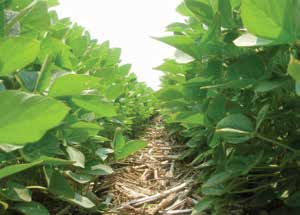chAPter 14 reduCing erosion and runoFF
may occur. For example, originally fertile soils on steep
• Structures generally focus on containing runoff and
slopes in southern Honduras are now severely eroded
sediment once erosion has been initiated, whereas ag-
(figure 14.2) after years of slash-and-burn agriculture.
ronomic measures try to prevent erosion from occur-
Management practices are available to help reduce
ring in the first place by decreasing runoff potential.
runoff and soil losses. For example, an Ohio experiment
• Structures are often expensive to build and maintain.
in which runoff from conventionally tilled and no-till
• Most structures do not reduce tillage erosion.
continuous-corn fields was monitored showed that over
The use of soil-building conservation management
a four-year period, runoff averaged about 7 inches of
practices is preferred for long-term sustainability of crop
water each year for conventional tillage and less than
production, and they are also the first choice for control-
0.1 inch for the no-till planting system. Researchers in
ling runoff and erosion. Structural measures still have
the state of Washington found that erosion on winter
a place, but that is primarily to complement agronomic
wheat fields was about 4 tons each year when a sod crop
measures. Erosion reduction works by either decreasing
was included in the rotation, compared to about 15 tons
the shear forces of water and wind or keeping soil in a
when sod was not included.
condition in which it can’t easily erode. Many conser-
vation practices actually reduce erosion by using both
ADDRESSINg RUNOFF AND EROSION
approaches. In general, the following are good principles:
Effective runoff and erosion control is possible with-
• Keep the soil covered; water and wind erosion occur
out compromising crop productivity. However, it may
almost exclusively when the soil is exposed.
require considerable investment or new management.
• Use management practices that increase aggregation
The numerous methods of controlling soil and water
and infiltration.
can be grouped into two general approaches: structural
• Do not loosen the soil unless it is well covered. Loose
measures and agronomic practices. Creating structures
soil is more erodible than stable soil, like in no-till
for reducing erosion generally involves engineer-
systems. Loosening may initially reduce runoff
ing practices, in which an initial investment is made
potential but this effect is generally short-lived, as
to build terraces, diversion ditches, drop structures,
the soil will settle. If loosening is required to reduce
etc. Agronomic practices that reduce erosion focus on
compaction, do it with tools that limit disturbance
changes in soil and crop management, such as reduced
(e.g., zone builders or strip tillers). Soil disturbance
tillage and cover cropping, and planting vegetation in
is also the single cause of tillage erosion.
critical areas. Appropriate conservation methods may
• Take a landscape-scale approach for additional
vary among fields and farms, but recently there has been
control. Focus on areas with high risk, those where
a clear trend away from structural measures in favor
runoff water concentrates, and maximize the use of
of agronomic practices. The primary reasons for this
inexpensive biological approaches like grass seeding
change are as follows:
in waterways and filter strips.
• Management measures help control erosion, while
• Focus on critical periods. For example, in temper-
also improving soil health and crop productivity.
ate areas the soil is most susceptible after the winter
• Significant advances have been made in farm ma-
fallow, and in semiarid regions it is most fragile after
chinery and methodologies for alternative soil and
the dry period when heavy rains begin and there is
crop management.
little surface cover. In some regions, heavy rainfall is
associated with hurricane or monsoon seasons.
155
Building SoilS for Better CropS: SuStainaBle Soil ManageMent





